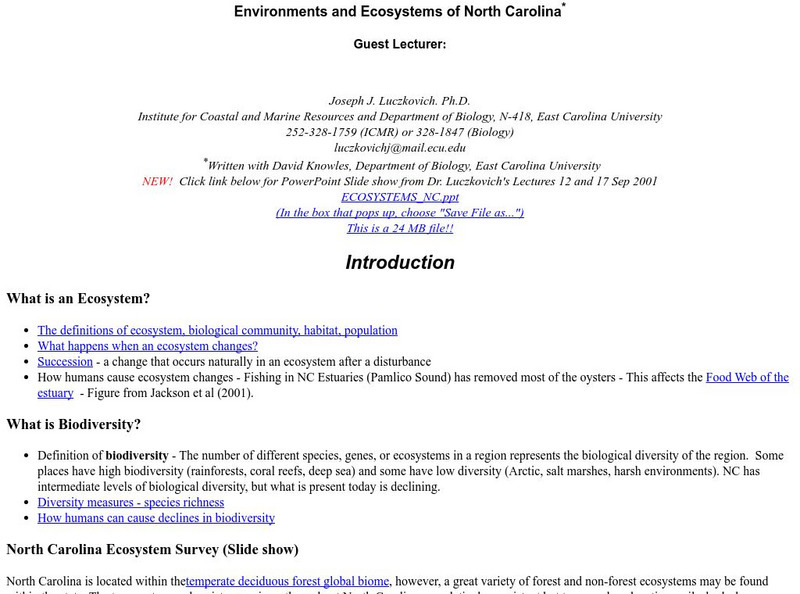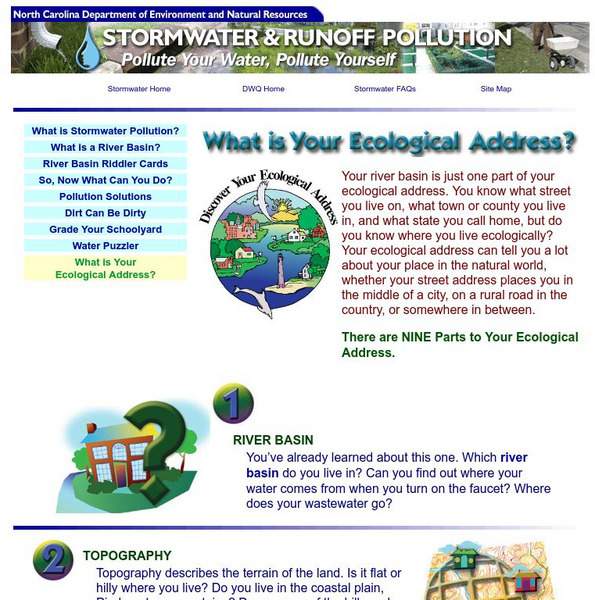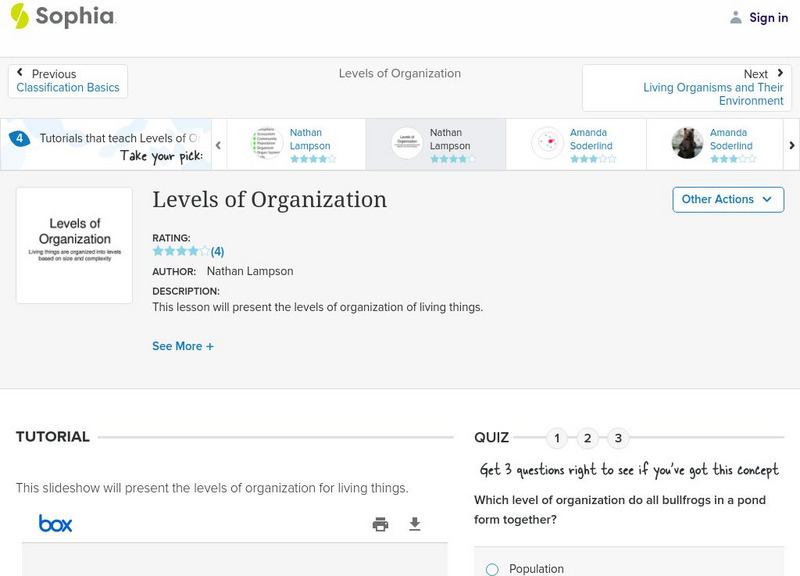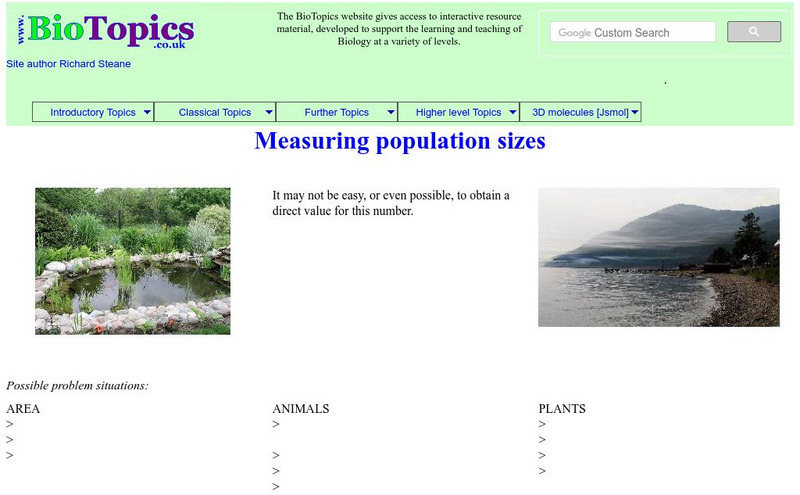Hi, what do you want to do?
Other
Greatest Places: Okavango Delta
Experience the Okavango, a "river that never meets the sea." Learn about the animals there, how to make papyrus, and swampy deltas.
Other
The Dirty Dozen Persistent Organic Pollutants
Use this site to learn about the effects of persistent organic pollutants on the ecology of Antarctic coastal waters. Information is presented for both teacher and student researcher.
Other
Marietta College: Ecosystems
Complete illustrated discussion of energy flow within ecosystems, including discussions of trophic levels, ecological pyramids, food chains and webs, biological magnification, and cycles.
Other
Environments and Ecosystems of North Carolina
North Carolina is located within the temperate deciduous forest global biome, however, a great variety of forest and non-forest ecosystems may be found within the state. The temperature and moisture regimes throughout North Carolina are...
Other
College of Du Page: Energy in an Ecosystem
Ecosystems contain two kinds of commodities: matter (nutrients) and energy. Nutrients cycle through the ecosystem, available for repeated use by organisms. These cycles of use and reuse are called biogeochemical cycles. Energy instead is...
Other
Nc Department of Energy and Natural Resources: What Is Your Ecological Address?
Your river basin is just one part of your ecological address. Your ecological address can tell you a lot about your place in the natural world, whether your street address places you in the middle of a city, on a rural road in the...
The College Board
The College Board: Ap Biology 2007 Scoring Guidelines [Pdf]
This scoring guide can be used as a study guide, provding examples and exemplary student responses. The topic covered is energy flow in ecosystems.
US Geological Survey
Mercury in the Geochemical Cycle
Mercury in the geochemical cycle ultimately affects the food chain. Learn about this and its effect on the Everglades.
US Geological Survey
Lake Pontchartrain Basin Foundation: Watershed
Explore the characteristics of a watershed through these multiple intelligences learning activities. Activities will help students define a watershed as well as read the features on a topographic map. Site also includes background...
US Geological Survey
Lake Pontchartrain Basin Foundation: Ecosystems in Delicate Balance
Learning activities to investigate how organisms interact in a functioning ecosystem. Young scholars will explore the role organisms play in food chains and preserving biodiversity in ecosystems. Lake Pontchartrain Basin ecosystem is...
Everything ESL
Everything Esl: Forest, Deserts and Grasslands
Biomes and Ecosystems unit will increase the interest of the ELL students. Lessons are based on the TESOL, ESL standards.
McGraw Hill
Glencoe Biology: Principles of Ecology: Chapter Test Practice
A set of fifteen comprehension questions which test over various ecological concepts.
McGraw Hill
Glencoe Biology: Biodiversity: Self Check Quiz
These five multiple-choice questions can be used for a quick, self-checking assessment over biodiversity.
Scholastic
Scholastic: Study Jams! Science: Ecosystems: Aquatic Ecosystems
A video and a short multiple-choice quiz on the topic of aquatic ecosystems. It discusses the difference between freshwater and saltwater ecosystems, then explains what the three ecozones are in a marine ecosystem.
Scholastic
Scholastic: Study Jams! Science: Ecosystems: Changes in Ecosystems
A video and a short multiple-choice quiz on the natural changes that take place in an ecosystem, and the negative impact humans can have on ecosystems.
Scholastic
Scholastic: Study Jams! Science: Ecosystems
A video and a short multiple-choice quiz on the topic of ecosystems, covering biotic and abiotic factors, and the roles organisms play in an ecosystem.
US Environmental Protection Agency
Epa: Surf Your Watershed
This resource provides information on watersheds, maps, activities, and links to local watershed information.
Scholastic
Scholastic: Study Jams! Science: Ecosystems: Food Webs
A video and a short multiple-choice quiz on food webs that explains the difference between food webs and food chains, and the relationships that exist between organisms.
Cynthia J. O'Hora
Mrs. O's House: Habitat Project Digital Science Journal
Develop a digital story to illustrate and inform others about different habitats or ecosystems. Resources for building a digital story are provided.
Sophia Learning
Sophia: Levels of Organization: Lesson 4
This lesson will present the levels of organization of living things. It is 4 of 6 in the series titled "Levels of Organization."
Bio Topics
Bio Topics: Food Chains and Webs
Trace the energy transfer through food chains and food webs. Check your understanding by hovering your mouse over questions to reveal the answers.
Bio Topics
Bio Topics: Measuring Population Sizes
Read and understand the concept of ecological population counts and sizes. Hover the mouse over questions to reveal the answers as you sharpen your skills.
Other
Western North Carolina Vitality Index: Ecosystem Threats
The forests of Western North Carolina are threatened by a wide variety of environmental stressors and disturbances, such as insects, disease, invasive species, drought, fire, hurricanes, tornadoes, and ice storms. A stressor is any kind...
Sophia Learning
Sophia: Abiotic and Biotic Factors: Lesson 2
This lesson will introduce abiotic and biotic factors, giving examples and comparing/contrasting the two. It is 2 of 4 in the series titled "Abiotic and Biotic Factors."


























